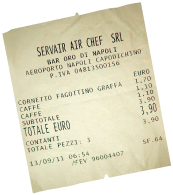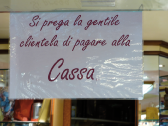3 Ordering and paying
In this activity you learn and practise the language needed to place an order in a café and you will find out more about il bar.
Activity 5
Maria and Piera have met for breakfast in a café. Listen to the audio track and try to work out what they are ordering. They seem to be placing their order twice. Do you know why that is?
Transcript
Transcript
Listen to Maria and Piera ordering drinks in a café and try to work out what they are ordering and why they seem to be ordering twice.
Cassiere Desidera?
Maria Vorrei un cappuccino e una brioche.
Piera E per me un caffè e una pasta.
Cassiere Quattro euro.
Maria Ecco.
Cassiere Ecco lo scontrino.
Maria Grazie.
Maria Scusi!
Barista Mi dica.
Maria Vorrei un cappuccino e una brioche.
Barista E per Lei?
Piera Per me un caffè e una pasta.
Barista Allora, un cappuccino, un caffè, una brioche e una pasta.
Answer
The two friends are having a cappuccino (un cappuccino), a brioche (una brioche), a coffee (un caffè) and a cake or pastry (una pasta). They pay at the till first and then go to the counter with the receipt and repeat their order.
Culture: Paying for drinks and snacks
In many bars and cafés, particularly in train stations, airports or more upmarket bars in cities, you go to the cash desk (la cassa) first and say what you want. You pay and are given a receipt (uno scontrino), which you then give to the person serving, repeating your order. In fact there is often a sign (un cartello) telling you to go the cash desk first, pay the cashier (il cassiere / la cassiera) and get a till receipt. The sign might say something like Si prega di fare lo scontrino alla cassa (‘Please obtain a receipt [first] from the till’) or simply Si prega di pagare alla cassa (‘Please pay [first] at the till’).
It is also worth remembering that in most cafés in Italian towns there are two sets of prices, both of which, by law, should be clearly displayed: the price you pay standing at the counter (al banco) and the price you pay sitting down at a table (al tavolo). In smaller towns or rural areas, there is usually only one set of prices and you can sit either inside or outside without paying extra.
 Figure 11 Uno scontrino |
 Figure 12 Un cartello |
|---|
Activity 6
The following expressions were used by the speakers in the previous dialogue. Match each expression to its English equivalent, as in the example, and then listen to the audio track again and see if you can hear them.
Example: 1 – f
| 1 Desidera? | (a) For me |
| 2 Vorrei | (b) How can I help? |
| 3 Per me | (c) For you |
| 4 Scusi! | (d) Here you are! |
| 5 Mi dica | (e) Excuse me! |
| 6 Per Lei | (f) What would you like? |
| 7 Allora | (g) I would like |
| 8 Ecco! | (h) So … |
Answer
1 – (f); 2 – (g); 3 – (a); 4 – (e); 5 – (b); 6 – (c); 7 – (h), 8 - (d)
Language: Ordering drinks
In an Italian bar, the person serving – or the cassiere if you have to pay first – will ask you what you want in one of the following ways:
- Desidera? What would you like? (literally: You want?)
- Mi dica. How can I help? (literally: Tell me.)
- E per Lei? (And) for you?
To say what you would like, use:
- Vorrei… I would like …
- (E) per me… (And) for me …
If you need to attract the waiter’s or barman’s attention, you say:
- Scusi! Excuse me!
When the person serving sums up the order to check that they have got it right, they usually begin with:
- Allora… So …
When they are serving your order, they are likely to say:
- Ecco! Here you are!
As a beginner, it is useful to learn common expressions like these as set phrases rather than trying to work out what each word means.
